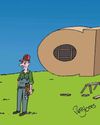
Whether or not you like suburbia, the first thing you notice about new suburbs W is that they all seem to start with fences.
They don't, of course. There are years of planning and resource consent hearings, followed by scraping back the topsoil and installing all the roads, pipes and services. Right at the end when it seems all is lost, the earth-moving equipment and trucks disappear, the grass is sown and the fences go up. It is only then that they begin to resemble what we have come to know as suburbia. Fences make them recognisable and, in this state, before all the houses are built, they are like ghost towns in reverse, full of potential and lives about to be lived.
There are those who pooh-pooh suburbia as the haven of the bourgeois and home of mediocrity. However, more than 84% of New Zealanders live this way and its popularity as a lifestyle is only growing. How we got here with suburbia and the fences that divide them is a quirky mix of the Industrial Revolution and capitalism at its best. It's an unlikely collision of the rise of the middle class and the repurposing of the agricultural fence.
Suburbia, as a way of urban living, has been around for more than 200 years and has spread like a weed throughout the modern world. In the early 19th century, it was observed that industrial London was made of concentric subcommunities described by writer John Murray as "like onions 50 on a rope". By its nature, industrialisation demanded large populations that required housing, transport infrastructure, and most importantly, the illusion of escape. The suburban form ticked all the boxes and began to proliferate. The early version of the suburb offered the romantic ideal of getting back to nature, combined with the dollar-making convenience of being near the city. It was a magical combination and a way of living that took off like the sales of a seafront subdivision.
Esta historia es de la edición November 11 - 17, 2023 de New Zealand Listener.
Comience su prueba gratuita de Magzter GOLD de 7 días para acceder a miles de historias premium seleccionadas y a más de 9,000 revistas y periódicos.
Ya eres suscriptor ? Conectar
Esta historia es de la edición November 11 - 17, 2023 de New Zealand Listener.
Comience su prueba gratuita de Magzter GOLD de 7 días para acceder a miles de historias premium seleccionadas y a más de 9,000 revistas y periódicos.
Ya eres suscriptor? Conectar

First-world problem
Harrowing tales of migrants attempting to enter the US highlight the political failure to fully tackle the problem.

Applying intelligence to AI
I call it the 'Terminator Effect', based on the premise that thinking machines took over the world.

Nazism rears its head
Smirky Höcke, with his penchant for waving with a suspiciously straight elbow and an open palm, won't get to be boss of either state.

Staying ahead of the game
Will the brave new world of bipartisanship that seems to be on offer with an Infrastructure Commission come to fruition?

Grasping the nettle
Broccoli is horrible. It smells, when being cooked, like cat pee.

Hangry? Eat breakfast
People who don't break their fast first thing in the morning report the least life satisfaction.

Chemical reaction
Nitrates in processed meats are well known to cause harm, but consumed from plant sources, their effect is quite different.

Me and my guitar
Australian guitarist Karin Schaupp sticks to the familiar for her Dunedin concerts.

Time is on my side
Age does not weary some of our much-loved musicians but what keeps them on the road?

The kids are not alright
Nuanced account details how China's blessed generation has been replaced by one consumed by fear and hopelessness.